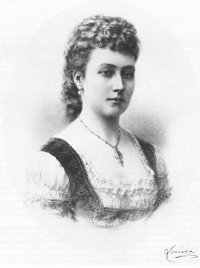 Princess Louise was born on March 18, 1848 at Buckingham Palace, the sixth child and fourth daughter of Queen Victoria and Prince Albert. She was named Louise Caroline Alberta by her father. Louise after her father's mother. Caroline, after Prince Albert's step-grandmother, the dowager duchess of Gotha. And Alberta after himself. During her early childhood she was called "Loo-Loo".
Princess Louise was born on March 18, 1848 at Buckingham Palace, the sixth child and fourth daughter of Queen Victoria and Prince Albert. She was named Louise Caroline Alberta by her father. Louise after her father's mother. Caroline, after Prince Albert's step-grandmother, the dowager duchess of Gotha. And Alberta after himself. During her early childhood she was called "Loo-Loo".Of Queen Victoria's five daughters she was considered the prettiest, the wittiest, and the best-dressed. She was also the most independent-minded and tempermental.
She was educated by governess at Windsor Castle in arithmetic, history, geography, grammar, as well as the art of court etiquette. She did well in French but not in German. She was considered to be the most artistic of the Queen's daughters and her mother, recognizing her undeniable talent, reluctantly allowed her to attend the Kensington National Art Training School in 1868, becoming the first monarch's daughter to be publicly educated. She eventually became an accomplished sculptor, writer and artist, designing a marble sculpture of her mother which stands at Kensington Palace overlooking the Round Pond and a monument in St. Paul's Cathedral to the fallen of the Boer War of 1899-1902.
Despite her talent, in her mother's eyes, her first duty was to marry. Instead of a foreign princeling, Queen Victoria looked to aristocratic circles. A non-royal match was considered rather novel at the time and had not occurred in the royal family in over 350 years. She married John Douglas Sutherland Campbell, Marquess of Lorne and heir to the Dukedom of Argyll on March 21, 1871 in St. George's Chapel, Windsor. He was known as Ian when he was younger but was called Lorne, after the courtesy title be bore, and he belonged to one of the oldest and most prominent families in the kingdom. The public looked forward to the wedding, Louise being called "The Maiden All for Lorne," and a London perfumer created a scent for the occasion called "Love-Lorne." The couple spent part of their honeymoon at Claremont House near Windsor and then took a tour of the Continent. She became Duchess of Argyll when her husband succeeded to the dukedom in 1900. The couple would have no children.
In 1878 Lorne was offered the governor-generalship of Canada. In addition to their official duties, the couple hosted sledding, sleighing, skating parties at Rideau Hall, and went canoeing and salmon-fishing expeditions. Princess Louise set up her own art studio at Rideau Hall, and encouraged the foundation of the Canadian Academy of Arts in 1880. During her husband's tenure as Governor General of Canada, regiments such as Princess Louise's Dragoon Guards, Quebec's Louise Embankment, Lake Louise in Banff National Park, and the province of Alberta were named after her.
Always interested in women's rights she founded the Ladies' Work Society, where women learned crafts of needlework, embroidery, thus enabling them to earn wages. She also sponsored an "Education Parliament" which became the Girls' Public School Day Company, where middle-class parents were given financial assistance to educate their daughters.
Her husband died in 1914 and she lived at Kensington Palace until her death on December 3, 1939 at the age of ninety-one. She was cremated and her ashes are buried in the Frogmore burial grounds.
© Marilyn Braun 2006


No comments:
Post a Comment